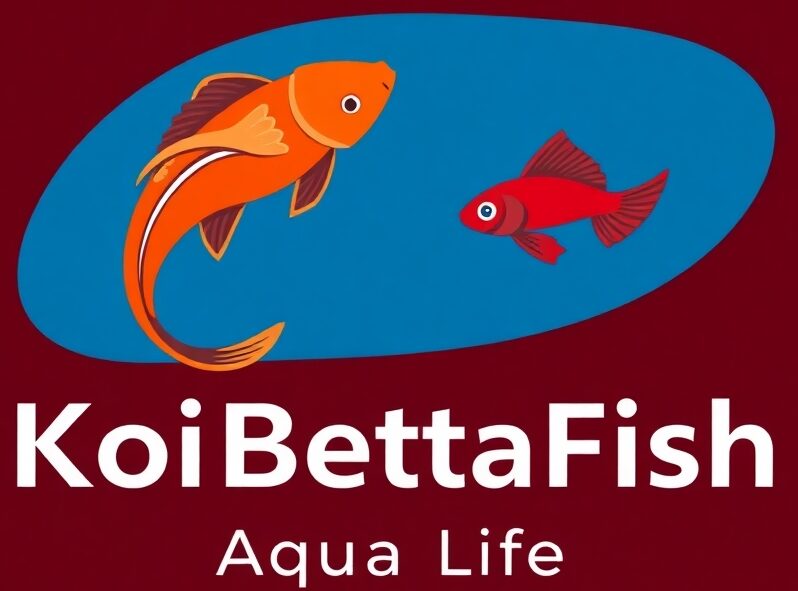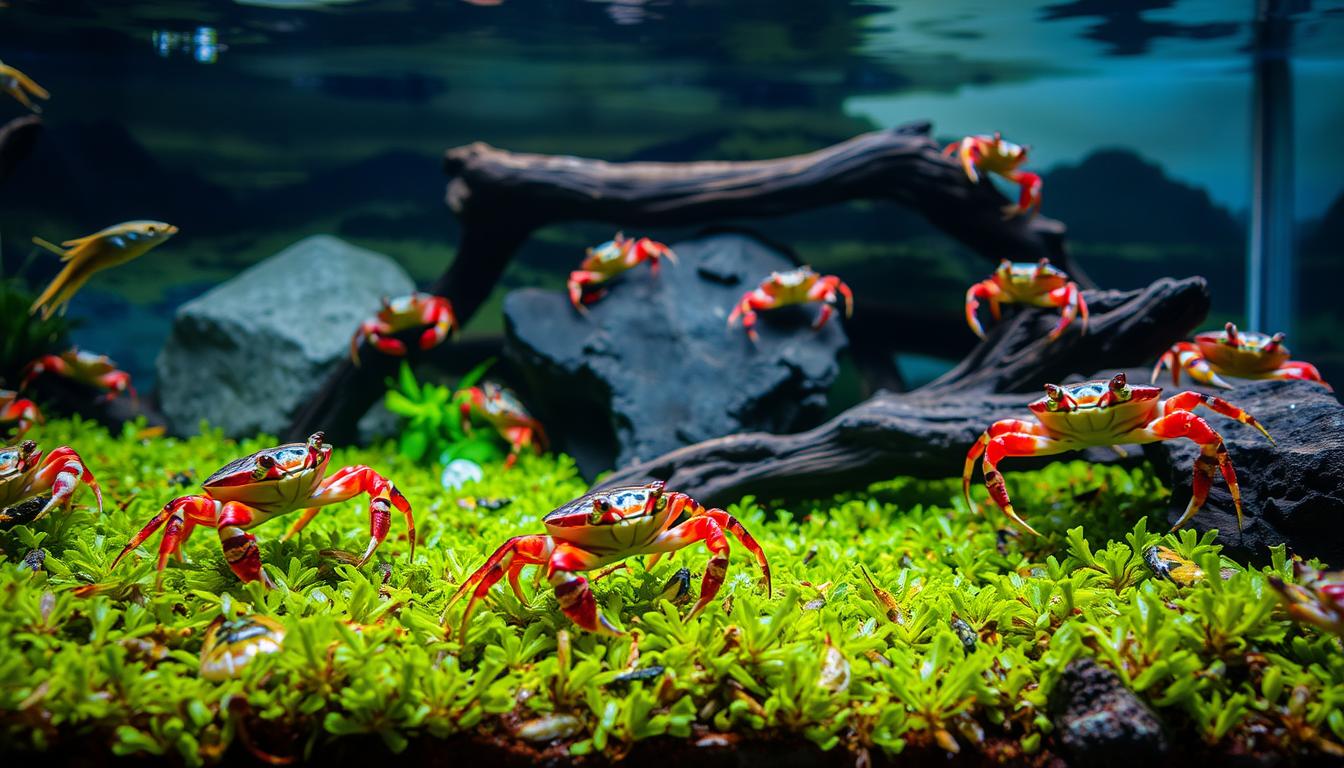Thinking of adding a unique touch to your tank? Freshwater crabs for aquarium setups are becoming increasingly popular among aquarists—and for good reason! These small, curious creatures bring life, movement, and character to any tank. Whether you’re new to the hobby or an experienced fish keeper, exploring the world of freshwater crabs for aquarium environments can open up exciting possibilities. In this guide, we’ll walk you through the best species to keep, how to care for them, and why freshwater crabs for aquarium lovers are raving about these fascinating crustaceans.
With their vibrant colors and intriguing behaviors, aquarium crabs are sure to captivate both novice and experienced aquarium enthusiasts alike. They are natural scavengers, helping to keep your tank clean by munching on leftover food and debris. By introducing freshwater crabs into your aquarium, you’ll not only enhance the aesthetic appeal but also create a more balanced ecosystem.
Key Takeaways
- Freshwater crabs add a unique touch to your aquarium with their vibrant colors and intriguing behaviors.
- They are natural scavengers, helping to keep your tank clean.
- Aquarium crabs are suitable for both novice and experienced aquarium enthusiasts.
- They help create a more balanced ecosystem in your tank.
- Freshwater crabs are a great addition to any aquarium, enhancing its aesthetic appeal.
Why Freshwater Crabs Make Excellent Aquarium Pets
Freshwater crabs are gaining popularity as aquarium pets, and for good reason! They bring a unique charm to your tank with their intriguing behaviors and characteristics.
Unique Behaviors and Characteristics
Freshwater crabs are not just visually appealing; they also exhibit fascinating behaviors. They are natural scavengers, helping to keep your tank clean by consuming uneaten food and algae. You might even catch them rearranging decorations or burrowing into the substrate! Their social dynamics can be quite interesting, making them a great conversation starter.
Benefits of Keeping Crabs vs. Other Aquatic Pets
So, why choose freshwater crabs over other aquatic pets? For one, they are relatively low maintenance compared to fish that require precise water conditions. Crabs are also quite hardy, making them perfect for beginners. Plus, they add a unique dimension to your aquarium, breaking the monotony of watching fish swim. With the right freshwater crab species, you can enjoy a thriving and diverse aquatic environment.
Popular Freshwater Crabs for Aquarium Enthusiasts
If you’re looking to add some excitement to your aquarium, consider one of the many fascinating freshwater crab species available! Freshwater crabs are not only intriguing creatures but also great additions to a well-planned aquarium, offering a unique blend of interesting behaviors and attractive appearances.
Fiddler Crabs
Fiddler crabs are known for their distinctive claw, which is used for communication and defense. They’re relatively small, making them a great choice for smaller tanks. Care requirements: temperature between 75-85°F, pH 6.5-8.0.
Thai Micro Crabs
Thai Micro Crabs are tiny, peaceful creatures that thrive in well-planted tanks. They’re ideal for nano aquariums and are relatively low maintenance. Tip: Ensure good water quality and provide plenty of hiding spots.
Red Claw Crabs
The Red Claw Crab is one of the most popular species for beginners. Its striking red claws and active nature make it a delightful addition to any tank. Key characteristics: omnivorous diet, requires both aquatic and terrestrial areas.
Vampire Crabs
Vampire Crabs are known for their striking appearance and interesting behaviors. They require a well-maintained tank with adequate humidity and temperature control. Care tip: maintain a temperature range of 75-82°F.
Panther Crabs
Panther Crabs are colorful and engaging, making them a popular choice among aquarium enthusiasts. They require a spacious tank with both water and land areas. Diet: varied, including vegetables and protein sources.
| Crab Species | Tank Requirements | Diet |
|---|---|---|
| Fiddler Crabs | Smaller tanks, 75-85°F, pH 6.5-8.0 | Omnivorous |
| Thai Micro Crabs | Nano aquariums, well-planted | Small, meaty foods |
| Red Claw Crabs | Aquatic and terrestrial areas | Omnivorous |
| Vampire Crabs | High humidity, 75-82°F | Varied, including vegetables |
| Panther Crabs | Spacious, with water and land areas | Varied, including vegetables and proteins |
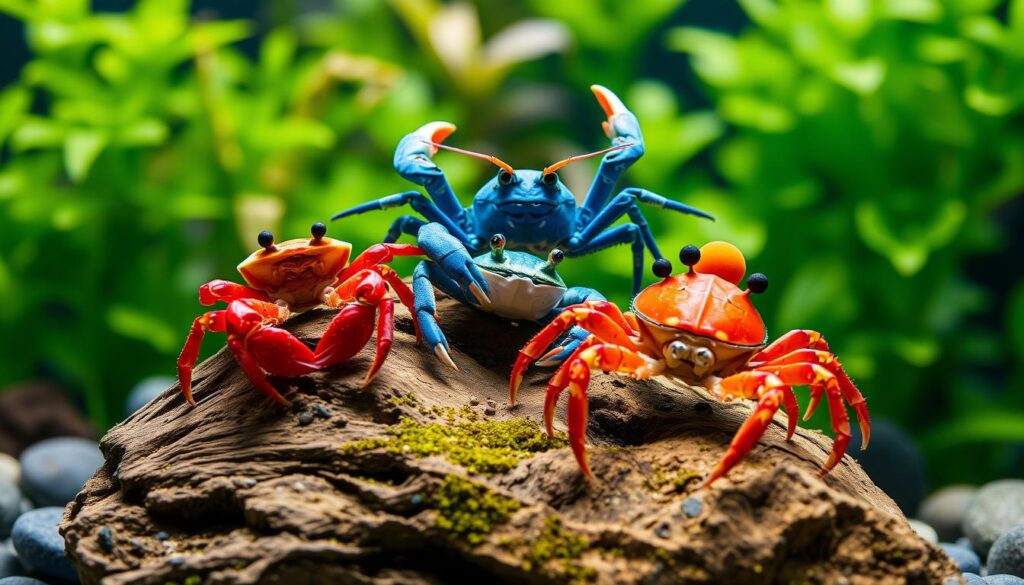
When choosing a freshwater crab, consider the specific needs of the species and ensure they fit with your aquarium setup. With the right care, these fascinating creatures can thrive and provide endless entertainment!
Understanding Freshwater Crab Behavior
To keep freshwater crabs thriving, it’s essential to understand their natural behaviors and social needs. Understanding their origin is essential for replicating their natural habitat in your home aquarium, which helps reduce stress and improve their overall health.
Natural Habits and Instincts
Freshwater crabs are naturally inclined to burrow and hide, behaviors that are crucial for their survival in the wild. Replicating these conditions in your aquarium can significantly enhance their well-being. You can achieve this by incorporating substrate that allows for burrowing and adding decorations that provide hiding spots.
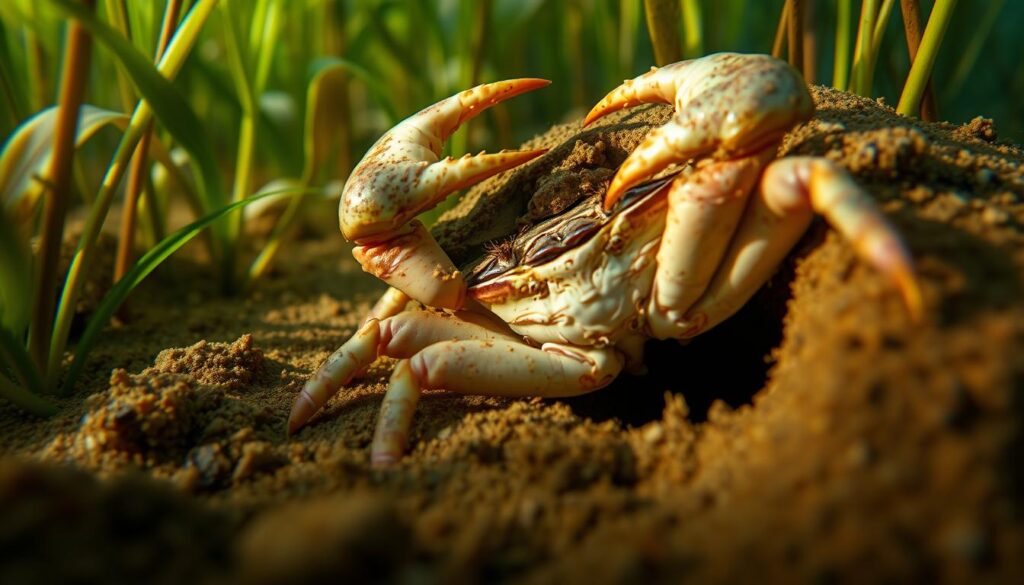
Social Dynamics in Captivity
When keeping aquarium crabs, it’s vital to consider their social dynamics. Some species are solitary and territorial, while others can be kept in small groups. Researching the specific social needs of your crab species is crucial for creating a harmonious aquarium environment.
Setting Up the Ideal Crab Habitat
Let’s dive into the world of freshwater crab care and explore how to create the perfect habitat for your crustacean friends! Setting up a suitable environment is crucial for their health and happiness.
Tank Size Requirements
When it comes to tank size, bigger is always better! For most freshwater crab species, a minimum tank size of 10 gallons is recommended. However, if you’re planning to keep multiple crabs or other tank mates, you’ll need an even larger tank.
Substrate Choices
The substrate you choose can make a big difference in your crab’s comfort and health. A mix of sand and soil is ideal, as it allows for burrowing and can help maintain humidity. Avoid using gravel or sharp substrates that can harm your crabs.
Decorations and Hiding Spots
Freshwater crabs love to hide and feel secure, so providing plenty of decorations and hiding spots is essential. You can use rocks, plants, and driftwood to create a natural environment. Make sure to leave some open space for your crabs to roam around!
Land Areas and Access Points
Since freshwater crabs are semi-aquatic, they need access to land areas. You can create a beach area or use a land zone specifically designed for aquariums. Ensure that the transition from water to land is smooth and safe for your crabs.
| Habitat Feature | Recommendation |
|---|---|
| Tank Size | Minimum 10 gallons |
| Substrate | Sand and soil mix |
| Decorations | Rocks, plants, driftwood |
| Land Areas | Beach area or land zone |
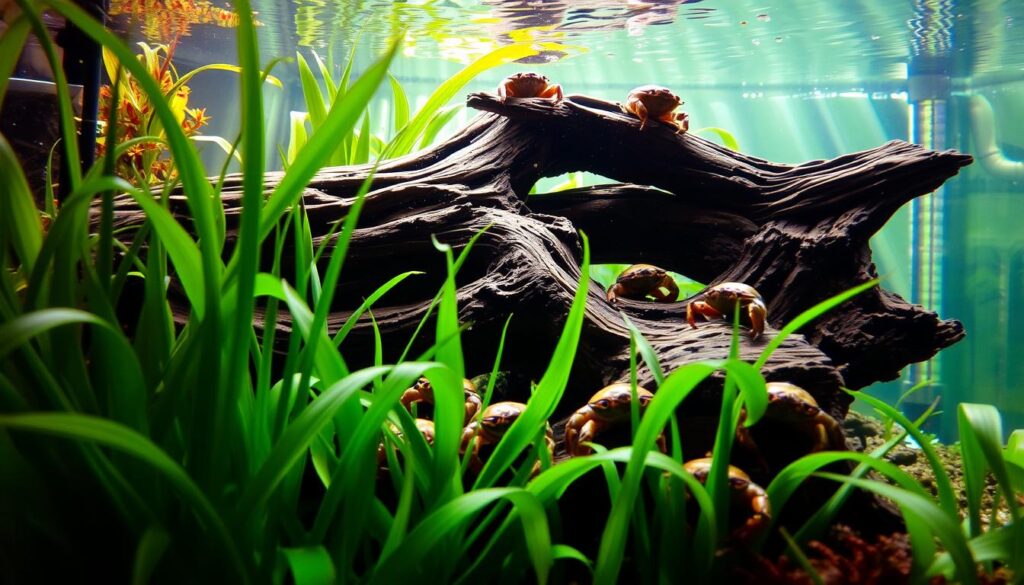
By following these tips, you’ll be well on your way to creating a thriving environment for your freshwater crabs. Happy aquarium keeping!
Creating the Perfect Water Conditions
When it comes to keeping freshwater crabs happy and healthy, water conditions are paramount! To create an ideal environment, we need to focus on several key factors.
Temperature Requirements
Freshwater crabs thrive in temperatures between 72-82°F (22-28°C). Maintaining a stable temperature within this range is crucial for their metabolism and overall health. You can achieve this by using a reliable aquarium heater.
pH and Hardness Levels
The pH level should be between 7.0 and 8.5, while water hardness should be moderate. Regularly check these parameters to ensure they remain within the suitable range for your crabs.
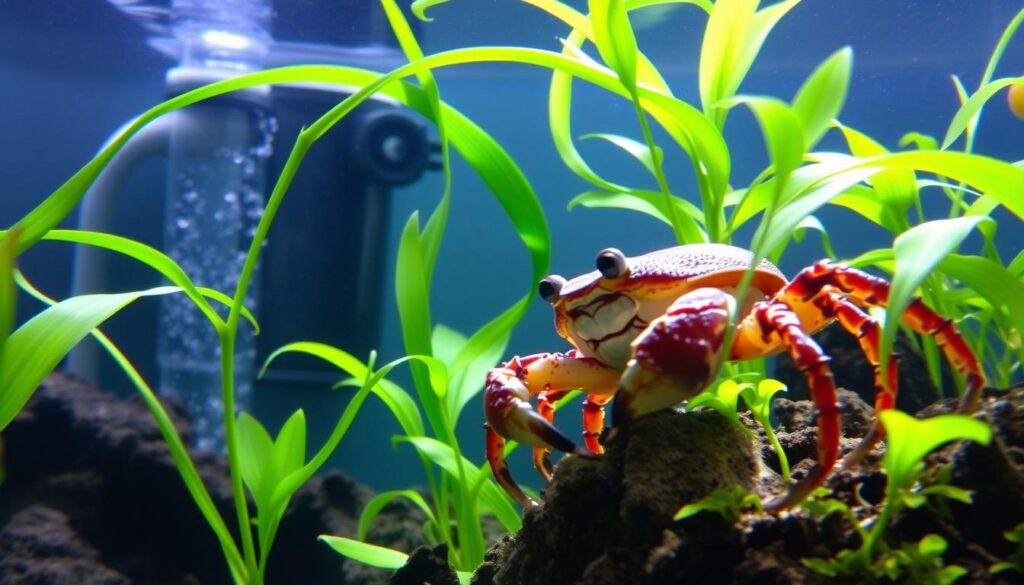
Filtration Needs
A good filtration system is vital for keeping the water clean and clear. It helps remove waste products and excess food, maintaining a healthy environment for your crabs.
Water Change Schedule
Regular water changes are essential. Replace about 25% of the tank water weekly to keep the water fresh and prevent the buildup of harmful substances.
| Parameter | Ideal Range |
|---|---|
| Temperature | 72-82°F (22-28°C) |
| pH Level | 7.0-8.5 |
| Water Hardness | Moderate |
| Water Change | 25% weekly |
Selecting the Best Freshwater Crabs for Aquarium Success
Selecting the perfect freshwater crabs for your tank is a crucial step in creating a thriving aquatic environment. With numerous species to choose from, it’s essential to pick crabs that are not only fascinating to watch but also well-suited to your aquarium conditions.
How to Choose Healthy Specimens
When choosing freshwater crabs, it’s vital to look for signs of good health. Here are some key indicators:
Visual Indicators of Health
- Active and Alert: Healthy crabs are active, moving around, and responsive to their surroundings.
- Intact Shell: Look for crabs with a hard, intact shell. Avoid those with soft spots or cracks.
- Vibrant Color: Crabs with vibrant, even coloring are generally healthier than those with dull or uneven coloration.
Behavior Signs to Watch For
- Feeding Behavior: Observe if the crabs are eating well. A healthy crab will readily accept food.
- Interaction with Environment: Crabs that interact with their environment, such as exploring or hiding, are likely healthy.
Where to Purchase Quality Crabs
You can find freshwater crabs at local pet stores or online retailers specializing in aquarium animals. When purchasing online, ensure the seller has a good reputation and provides healthy, well-cared-for crabs.
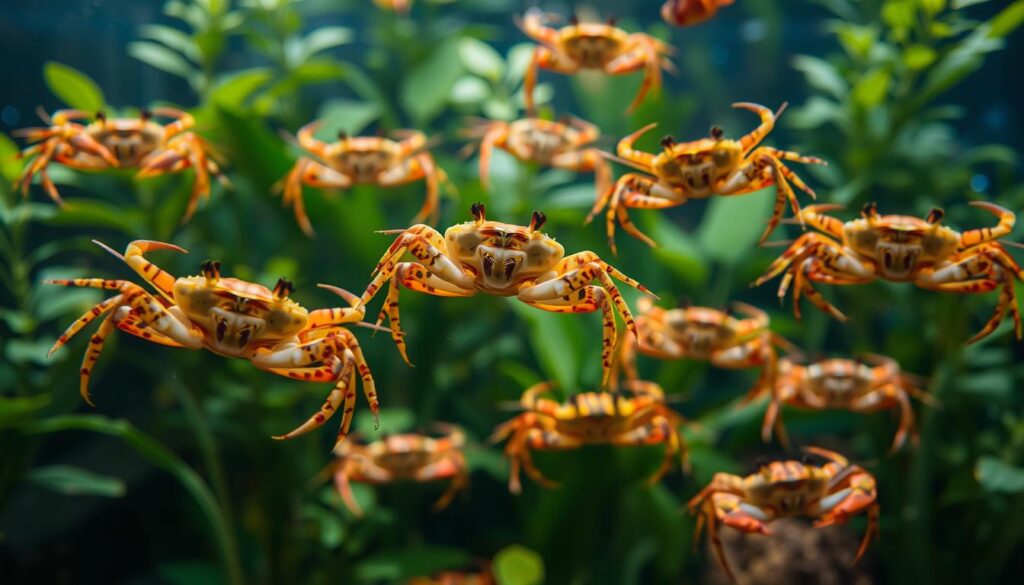
Acclimation Procedures
Acclimating your new crabs to your tank is crucial. Start by floating the crabs in a bag on the tank’s surface to equalize the temperature. Then, gradually add tank water to the bag over a period of time before releasing the crabs into the tank.
Read Also Caring for Turtles in an Aquarium: Tips and Tricks
Feeding Your Freshwater Crabs
Feeding your freshwater crabs a balanced diet is crucial for their health and longevity. A well-balanced diet ensures that your crabs get all the necessary nutrients for optimal health.
Natural Diet in the Wild
In their natural habitat, freshwater crabs are omnivores, feeding on a variety of food sources including algae, aquatic plants, insects, and even small fish. They play a vital role in their ecosystems by helping to clean up decaying matter.
Commercial Foods
For aquarium-kept crabs, high-quality commercial foods such as crab pellets or sinking shrimp pellets make an excellent staple. These foods are formulated to meet the nutritional needs of crustaceans.
Homemade Food Options
Supplementing with homemade foods can add variety to your crab’s diet. Blanched vegetables like spinach, zucchini, and peas are excellent sources of fiber and nutrients.
Feeding Schedule and Amounts
It’s essential to establish a regular feeding schedule. Feed your crabs once or twice a day, only as much as they can consume within a few hours. Overfeeding can lead to water quality issues.
| Food Type | Frequency | Quantity |
|---|---|---|
| Commercial Pellets | Daily | As much as they can eat in a few hours |
| Blanched Vegetables | 2-3 times a week | A few pieces per crab |
Compatible Tank Mates for Freshwater Crabs
When it comes to keeping freshwater crabs in a community tank, choosing the right tank mates is crucial for a harmonious aquarium environment. You want to ensure that your crabs and their tank mates coexist peacefully, so let’s dive into some compatible options!
Fish Species That Work Well
For a thriving community tank, consider fish that are fast swimmers and tend to stay in the mid to upper levels of the tank. Some great options include:
- Small schooling fish like neon tetras or harlequin rasboras
- Bottom-dwelling fish aren’t ideal as tank mates because they might compete with your crabs for food or space, but some species like corydoras catfish can work if you’re cautious
Invertebrates to Consider
In addition to fish, certain invertebrates can make great tank mates for your freshwater crabs. Here are a few to consider:
- Snails are a great choice as they’re generally easy-going and can help with algae control
- Other crabs can be kept together if you provide a large enough tank with plenty of hiding spots
The Molting Process: Critical for Crab Health
Freshwater crabs, like all crustaceans, undergo a process called molting, which is essential for their growth and survival. Molting is a natural process where the crab sheds its old exoskeleton to accommodate its growing body. As crab owners, understanding this process can help you provide better care for your pets.
Understanding the Molting Cycle
The molting cycle is a complex process influenced by factors such as nutrition, environment, and genetics. During molting, crabs may hide more often and appear vulnerable. It’s crucial to ensure that your tank provides plenty of hiding spots to reduce stress on your crabs.
| Pre-Molting Signs | Molting Process | Post-Molting Care |
|---|---|---|
| Reduced activity, loss of appetite | Crab sheds its exoskeleton | Provide a nutritious diet |
| Hide more frequently | New exoskeleton hardens | Ensure adequate calcium |
Supporting Crabs During Molting
To support your crabs during molting, make sure their environment is stress-free and well-equipped with hiding places. A well-balanced diet rich in calcium is also crucial for helping their new exoskeleton harden properly. By understanding and supporting your crabs through this process, you’re providing the best possible care for these fascinating creatures.
By following these freshwater crab care tips, you can help ensure your crabs navigate the molting process successfully. Remember, a happy crab is a healthy crab!
Health Issues and Disease Prevention
A healthy crab is a happy crab, and we’re here to share tips on keeping yours in top shape! Freshwater crabs can be sensitive to their environment, so maintaining good water quality is crucial for their health.
Common Health Problems
Poor water quality can lead to a range of health issues, including bacterial infections and parasites. Regular water changes and a good filtration system are essential for keeping aquarium crabs healthy. Some common health problems include shell damage, fungal infections, and respiratory issues.
Signs of Stress and Illness
So, how do you know if your crab is stressed or ill? Look out for signs like lethargy, loss of appetite, or unusual behavior. If you notice any of these symptoms, it’s time to investigate further and take action to address the issue.
Read Also Effortless Aquarium Sand Cleaning: Keep Your Tank Looking Its Best
Treatment Options
If your crab does fall ill, don’t panic! There are various treatment options available, from improving water quality to administering medication. Always research the best course of treatment for your crab’s specific condition, and consult with a veterinarian if necessary. By following these freshwater crab care tips, you can help ensure your crabs live a long and healthy life.
Breeding Freshwater Crabs in Home Aquariums
For those who are adventurous, breeding freshwater crabs in home aquariums can be a thrilling challenge. Breeding freshwater crabs requires careful planning and attention to detail, but with the right setup and knowledge, it can be a rewarding experience!
Breeding Requirements
To breed freshwater crabs successfully, you’ll need a separate tank with plenty of hiding spots. Some species, like the popular Thai Micro Crabs, require brackish water for larvae development. Ensure your tank is set up to meet these specific needs. Research the specific breeding requirements for your crab species, as they can vary significantly.
Caring for Crab Larvae and Juveniles
Caring for crab larvae and juveniles is a delicate process. Larvae need tiny food particles, such as rotifers or infusoria, while juveniles require a diet rich in protein. Maintain optimal water conditions and provide a varied diet to ensure healthy growth. Monitor their development closely, as the larvae and juveniles are vulnerable to disease and predation.
Conclusion
Choosing the right freshwater aquarium crabs can be an exciting and rewarding process! Whether you’re drawn to the vibrant colors of the Vampire Crab or the energetic nature of the Red Claw Crab, these creatures will bring life to your tank. By understanding their behavior, providing the ideal habitat, and caring for their needs, you’ll be well on your way to creating a thriving aquarium.
As we’ve explored, caring for freshwater crabs requires attention to detail and a commitment to providing the right environment. By following the guidelines outlined in this article, you’ll be able to enjoy the many benefits of keeping freshwater aquarium crabs. So, get ready to dive into the world of freshwater crab keeping and discover the joy of caring for these fascinating creatures!
